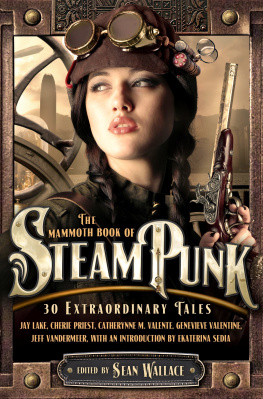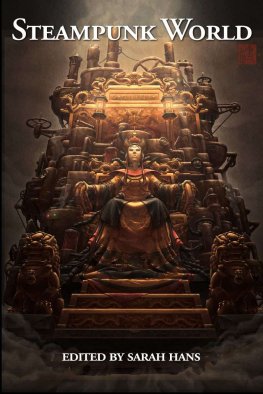Sean Wallace is the founder and editor of Prime Books, which won a World Fantasy Award in 2006. In the past he was co-editor of Fantasy Magazine as well as Hugo Award-winning and two-time World Fantasy nominee Clarkesworld Magazine; the editor of the following anthologies: Best New Fantasy, Fantasy, Horror: The Best of the Year, Jabberwocky, Japanese Dreams and The Mammoth Book of Steampunk; and co-editor of Bandersnatch, Fantasy Annual, Phantom and Weird Tales: The 21st Century. He lives in Rockville MD with his wife, Jennifer, and their twin daughters, Cordelia and Natalie.
Other Mammoth titles
The Mammoth Book of Pirates
The Mammoth Book of Men OWar
The Mammoth Book of Mindblowing SF
The Mammoth Book of Best New SF 22
The Mammoth Book of Boys Own Stuff
The Mammoth Book of Brain Teasers
The Mammoth Book of Merlin
The Mammoth Book of New Sherlock Holmes Adventures
The Mammoth Book of The Beatles
The Mammoth Book of the Best Short SF Novels
The Mammoth Book of Chess
The Mammoth Book of Quick Puzzles
The Mammoth Book of New IQ Puzzles
The Mammoth Book of Alternate Histories
The Mammoth Book of Apocalyptic SF
The Mammoth Book of Great British Humour
The Mammoth Book of Fun Brain Training
The Mammoth Book of Dracula
The Mammoth Book of Tattoo Art
The Mammoth Book of Bob Dylan
The Mammoth Book of Mixed Martial Arts
The Mammoth Book of Codeword Puzzles
The Mammoth Book of Best New SF 24
The Mammoth Book of Really Silly Jokes
The Mammoth Book of Undercover Cops
The Mammoth Book of Weird News
The Mammoth Book of Lost Symbols
The Mammoth Book of Conspiracies
The Mammoth Book of Antarctic Journeys
The Mammoth Book of Muhammad Ali
Edited by Sean Wallace

Constable & Robinson Ltd
5556 Russell Square
London WC1B 4HP
www.constablerobinson.com
First published in the UK by Robinson,
an imprint of Constable & Robinson Ltd, 2012
Copyright Sean Wallace, 2012 (unless otherwise stated)
The right of Sean Wallace to be identified as the
author of this work has been asserted by him in accordance
with the Copyright, Designs & Patents Act 1988.
This is a work of fiction. Names, characters, places and incidents are
either the product of the authors imagination or are used fictitiously,
and any resemblance to actual persons, living or dead,
or to actual events or locales is entirely coincidental.
All rights reserved. This book is sold subject to the condition
that it shall not, by way of trade or otherwise, be lent, re-sold,
hired out or otherwise circulated in any form of binding or cover
other than that in which it is published and without a similar condition
including this condition being imposed on the subsequent purchaser.
A copy of the British Library Cataloguing in Publication
Data is available from the British Library
UK ISBN: 978-1-84901-736-7 (paperback)
UK ISBN: 978-1-78033-135-5 (ebook)
1 3 5 7 9 10 8 6 4 2
First published in the United States in 2012 by Running Press Book Publishers,
A Member of the Perseus Books Group
All rights reserved under the Pan-American and International Copyright Conventions
This book may not be reproduced in whole or in part, in any form or by
any means, electronic or mechanical, including photocopying, recording,
or by any information storage and retrieval system now known or
hereafter invented, without written permission from the publisher.
Books published by Running Press are available at special discounts for bulk purchases
in the United States by corporations, institutions, and other organizations. For
more information, please contact the Special Markets Department at the Perseus
Books Group, 2300 Chestnut Street, Suite 200, Philadelphia, PA 19103, or call
(800) 810-4145, ext. 5000, or e-mail .
US ISBN: 978-0-7624-4468-7
US Library of Congress Control Number: 2011930509
9 8 7 6 5 4 3 2 1
Digit on the right indicates the number of this printing
Running Press Book Publishers
2300 Chestnut Street
Philadelphia, PA 19103-4371
Visit us on the web!
www.runningpress.com
Printed and bound in the UK
Contents
by Ekaterina Sedia
by Jeff VanderMeer
by Caitln R. Kiernan
by E. Catherine Tobler
by Jay Lake
by Genevieve Valentine
by Cat Rambo
by Shweta Narayan
by Aliette de Bodard
by N. K. Jemisin
by Peter M. Ball
by Sharon Mock
by Catherynne M. Valente
by Alex Dally MacFarlane
by Eileen Gunn & Michael Swanwick
by Tobias S. Buckell
by Matthew Kressel
by Margo Lanagan
by Amal El-Mohtar
by Barth Anderson
by Jeffrey Ford
by James Morrow
by Cherie Priest
by Margaret Ronald
by Megan Arkenberg
by Benjamin Rosenbaum
by Mary Robinette Kowal
by Samantha Henderson
by Nick Mamatas
by Nicole Kornher-Stace
by Lavie Tidhar
Steampunk: Looking to the Future Through the Lens of the Past
Ekaterina Sedia
With the recent release of The Steampunk Bible (ed. Jeff VanderMeer and SJ Chambers), it seems that steampunk as a genre finally came into its own and has grown enough to demand its own compendium, summarizing various parts of this remarkably protean movement, and pointing out interesting things happening in its DIY culture, cosplay, film, literature and music. The fact that the steampunk esthetic penetrates all aspects and art forms indicates that it is remarkably malleable and yet recognizable. We often see steampunk as gears and goggles glued to top hats, but this impression is of course superficial, and there is much more complexity to the fashion and maker aspects of it just take a look at the Steampunk Workshop website by Jake Von Slatt if you dont believe me! And yet, much like pornography, all of these expressions conform to a common pattern difficult to describe beyond the superficial, but one just knows it when one sees it.
And of course the literary component of the genre has complexity beyond what is visible to a casual reader. Some will think of early steampunk, as envisioned by Powers, Baylock and Jeter; others will recall the retrofuturism of Wells and Verne; yet others will shrug and deride faux Victoriana with its grafted-on machinery. The beauty of steampunk is that none would be wrong much like trying to determine the shape of an elephant by feel, summarizing literary steampunk is daunting, and it is tempting to grab a trunk and call it an elephant. It is tempting to say that in order to be properly steampunk, a story needs to be an alternate history, or to be set in Victorian England, or at least have an airship or two. And surely there cannot be steampunk without steam engines?
Next page














